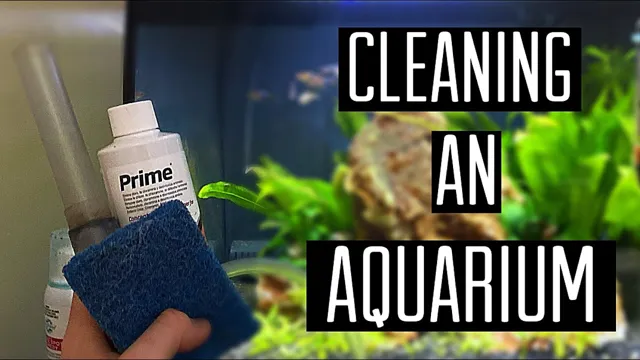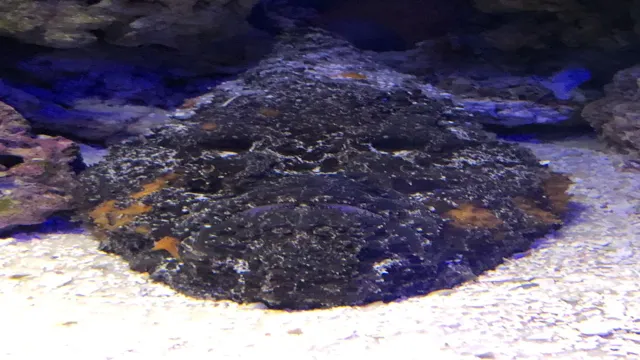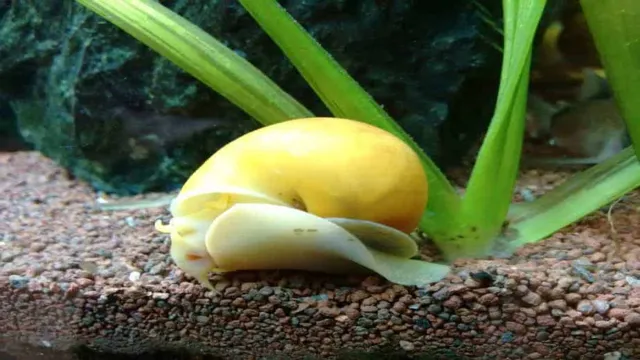How to Clean Aquariums for an Experiment: A Step-by-Step Guide

Have you ever thought about using aquariums for your scientific experiments? It’s a convenient and straightforward way to observe aquatic life and study their behavior. However, to ensure the accuracy of your research, maintaining a clean aquarium is crucial. A dirty tank can influence the water’s chemistry and affect the health of the fish and other aquatic creatures that live inside.
In this blog post, we will discuss the essential steps to clean your aquarium properly and keep your experiment thriving. So, let’s dive into the world of aquatic research and learn how to take care of your fish tank.
Preparing the Aquarium for Cleaning
When preparing an aquarium for cleaning, it is important to take a few steps to ensure that the process goes smoothly and safely. First, turn off any electrical equipment in the tank, such as heaters or powerheads, to prevent any accidents. Next, remove any decorations or plants from the tank and place them in a separate container with aquarium water to keep them safe and prevent damage.
Drain the water from the tank into a container or bucket using a siphon hose, being careful not to disturb any substrate or livestock in the tank. Once the tank is empty, remove any remaining debris or waste with a net or vacuum, and then wipe down the glass or acrylic surfaces with a clean sponge or cloth. It is important to avoid using any chemicals or cleaners that may harm the tank or its inhabitants.
Overall, taking the time to properly prepare and clean your aquarium is essential for maintaining a healthy and thriving aquatic environment for your experiment.
Removing Plants and Decorations
When it comes to preparing your aquarium for a thorough cleaning, removing plants and decorations is an important first step. Start by turning off all the equipment and unplugging any electrical devices. This will ensure your safety and prevent any mishaps.
If you have live plants in the aquarium, don’t worry about removing them entirely. Instead, trim them to about half their original size, so they don’t get in the way during cleaning. If you have any decorations or ornaments, these should be thoroughly cleaned as well.
Scrub them gently using a soft-bristled brush and mild soap, ensuring that you don’t damage the surface in any way. Once everything has been removed and cleaned, it’s vital to give the aquarium a good once-over to check for any faults or cracks in the glass. If you do happen to find any damage, don’t proceed with the cleaning until the issue has been resolved.
By taking the time to prepare your aquarium correctly, you’ll ensure that it stays healthy and that your fish are happy for years to come.

Draining the Water
Preparing your aquarium for cleaning can seem like a daunting task, but it’s an essential part of maintaining a healthy environment for your aquatic pets. One of the first steps in this process is draining the water. First, turn off all electrical equipment such as filters, heaters, and air pumps to avoid the risk of electrocution.
Then, use a siphon to remove the water. This will also help to remove debris that has accumulated on the aquarium floor. It’s important to make sure that you don’t siphon more than 50% of the water at once, as sudden changes in the water chemistry can harm your fish.
Once all the water has been drained from the tank, you can begin cleaning the tank and its accessories. Don’t forget to rinse everything thoroughly and allow it to dry before refilling the tank with fresh water and adding your fish back in. By taking the time to properly prepare your aquarium for cleaning, you’ll help ensure the health and happiness of your aquatic pets.
Cleaning the Gravel
Cleaning the gravel is a crucial step in preparing your aquarium for a thorough cleaning. The gravel at the bottom of your tank is home to a lot of debris, uneaten food, and waste material that can harm your fish and other aquatic creatures. Before cleaning the gravel, you should remove any excess debris floating in the water using a net.
Once you’ve done that, start siphoning the water out of the aquarium using a gravel vacuum. This will help remove any unwanted material that is buried deep in the gravel. Make sure to vacuum all the areas thoroughly, particularly those with heavy amounts of waste.
Cleaning the gravel will ensure that the water in your aquarium is clean and free of any harmful debris, helping your fish and plants thrive.
Cleaning the Glass and Decorations
When setting up an aquarium for an experiment, it is important to keep the glass and decorations clean to create a healthy environment for the aquatic inhabitants. To clean the glass, start by unplugging any equipment and removing any fish or plants to a separate container. Then, using a clean sponge or scraper, gently remove any algae or debris from the glass.
For stubborn spots, a razor blade can be used, but be careful not to scratch the glass. Once the glass is clean, use a fresh sponge and warm water to wipe down any decorations, removing dust and buildup. It is important to avoid using soap or chemicals as they can harm the fish.
Once the cleaning is complete, rinse everything thoroughly with fresh water and slowly reintroduce the fish and plants. By regularly cleaning the glass and decorations, your aquarium will not only look great for your experiment but will also provide a safe and healthy home for your aquatic inhabitants.
Using a Scraper and Algae Pad
When it comes to keeping your aquarium clean and healthy, cleaning the glass and decorations is a crucial task. To accomplish this, you’ll need a scraper and algae pad. Start by using the scraper to remove any stubborn algae from the glass.
Be gentle but firm, and make sure to scrape the entire surface. Once you’ve removed the algae, use the algae pad to scrub away any remaining debris. This will help to prevent future algae growth and keep your aquarium looking clear and pristine.
When cleaning decorations, it’s important to remember that some may require special care or cleaning solutions. Always check the manufacturer’s instructions before attempting to clean your decorations. With a little bit of effort and the right tools, you can keep your aquarium clean and healthy for your fish to thrive!
Cleaning Decorations and Plants
It is crucial to keep your aquarium clean, not only for the health of your fish but also to maintain the aesthetic appeal of your tank. When cleaning the glass and decorations, it’s essential to avoid harsh chemicals as they can harm your aquatic pets. Always use a soft-bristled brush or sponge to clean the glass, and gently scrub away any algae or buildup.
When cleaning decorations, you can remove them from the tank and rinse them thoroughly with warm water. If there are stubborn stains, you can use a cleaning solution specifically designed for aquariums. Similarly, when cleaning live plants, make sure to use a gentle method as harsh scrubbing can damage the leaves.
Use a soft brush to gently remove any dirt or algae from the plant surface, and avoid using bleach or other chemicals. A clean aquarium is not only pleasing to the eye, but it also creates a healthy environment for your aquatic friends to thrive and flourish.
Refilling the Aquarium
If you’re planning to conduct an experiment with your aquarium, it’s crucial to start by cleaning it properly. The first step is to do a partial water change, which involves removing 20-30% of the existing water and replacing it with fresh dechlorinated water. Next, it’s vital to remove any debris or waste from the bottom of the tank using a siphon or vacuum.
You should also clean the tank walls with an aquarium-safe scrubber or sponge to remove any built-up algae or other residue. Afterward, it’s time to refill the aquarium, making sure to match the water temperature and pH levels with the fish’s natural habitat. Finally, be sure to test the water regularly for any imbalances and make adjustments as needed.
By following these simple steps, you’ll have a clean and safe aquarium that’s ready for your experiment.
Adding Clean Water
When it comes to refilling your aquarium, the most important thing you should keep in mind is adding clean water. You don’t want to introduce any harmful substances or bacteria into your fish’s home. It’s best to use a water testing kit to check the levels of ammonia, nitrate, and nitrite in the water before refilling the tank.
If those levels are high, you’ll need to perform a partial water change before adding clean water. When adding water, make sure it’s at the same temperature and pH level as the existing water. This will prevent shock to the fish and maintain a stable environment.
You can use a dechlorinator to remove any harmful chemicals that may be present in the tap water. By taking these simple precautions, you’ll be able to maintain a healthy and thriving environment for your aquatic pets.
Reintroducing Plants and Decorations
Refilling an aquarium after a thorough cleaning is an exciting and rewarding task. When it comes to introducing plants and decorations, it’s important to consider the specific needs of your aquatic pets. Adding live plants can provide essential oxygen while creating a natural and beautiful environment for your fish to thrive in.
There are a variety of aquatic plants that can suit different types of aquarium setups, from low light to high tech. Gravel and rocks can also be added to provide additional hiding places for your fish and create a more natural-looking environment. It’s important to choose decorations that won’t harm your fish or plants, such as ornaments made specifically for aquarium use.
Overall, refilling your aquarium with new plants and decorations can provide a fresh and visually pleasing environment for your aquatic pets to enjoy.
Maintaining a Clean Aquarium
Maintaining a clean aquarium is essential for the overall health and well-being of the fish living within it. Before starting an experiment, it is crucial to ensure that the aquarium is free from debris, algae, and any other contaminants that may affect the results. First, empty a third to a half of the water from the aquarium, being careful not to disturb the plants, substrate or decorations that may be present.
Next, gently remove any debris, dead plant matter or uneaten food with a soft sponge or scraper. Algae can be removed using a sponge or scraper specifically designed for aquarium cleaning. After removing all the debris, it is now time to change the water.
To do so, simply fill a bucket with fresh water and add a water conditioner to remove any chlorine or other chemicals. Slowly pour in the new water, taking care not to disturb anything inside the aquarium. In conclusion, a clean aquarium is a healthy aquarium, and ensuring that it is clean is crucial for any experiment involving fish.
Conclusion
In conclusion, cleaning an aquarium for an experiment requires more than just a simple wipe down. It takes careful consideration of the fish and their environment, strategic planning of water changes, and a little patience to ensure success. So, grab your sponges, don your rubber gloves, and get ready to dive into the world of scientific discovery – because cleaning an aquarium for an experiment is truly an art form!”
FAQs
What supplies do I need to clean an aquarium for an experiment?
You will need an aquarium scrubber, a bucket, a siphon hose, and a water conditioner.
Can I use regular tap water to clean my aquarium for an experiment?
Yes, you can use tap water, but make sure to treat it with a water conditioner to remove chlorine and other chemicals.
How often should I clean my aquarium for an experiment?
It depends on the size of your tank and the number of fish. As a general rule, you should clean your aquarium once a week.
Should I remove my fish from the aquarium when cleaning it for an experiment?
It is recommended to remove the fish from the aquarium during the cleaning process. This will prevent them from being stressed or harmed.
How do I clean the accessories in my aquarium for an experiment?
You can clean the accessories in your aquarium by using a soft-bristled brush or sponge and aquarium-safe cleaning supplies.
What is the best way to prevent algae growth in my aquarium for an experiment?
To prevent algae growth, make sure you don’t overfeed your fish, limit the amount of sunlight, and perform regular water changes.
Can I use vinegar to clean my aquarium for an experiment?
You can use vinegar to clean your aquarium, but make sure to rinse it thoroughly to avoid any residue that may harm your fish.






